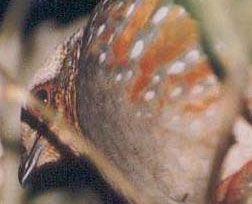 |
Yasser Arafat. "Watching wild life is my hobby from the beginning. Recently I completed MBA but not interested in that type of work. I wanted to do something for the
conservation of endangered wild animals and birds of Himalaya. I have started wild life photography and videography from last one year and have plenty of genuine knowledge of Pheasants and wild animals of Himalaya."
|
 To see wild animals and birds and to find out still unknown facts about them, this is my hobby. Going to the remotest part of a forest where no one has gone, is what I like doing best. I like trekking to these parts, climbing a difficult mountain, just
for the satisfaction of seeing a small shy bird and observing it without being seen by it.
To see wild animals and birds and to find out still unknown facts about them, this is my hobby. Going to the remotest part of a forest where no one has gone, is what I like doing best. I like trekking to these parts, climbing a difficult mountain, just
for the satisfaction of seeing a small shy bird and observing it without being seen by it.
To recognize the sounds of different birds and animals, to know where they are found, and to ponder on why Mother Nature created them- questions keep coming to my mind and time flies.
I have been visiting jungles near my house ever since I can remember. Now my days are filled with trekking, photographing, capturing a movement on video.
When I first heard about the mountain blue quail, I decided to go in search of it. I have searched far and wide and in the process managed seeing many other interesting species around the 70-80 sq.km jungle where I live. I have
come to know their numbers, where they live, and how to locate them from the various sounds they make.
Almost every day, I wake up in the morning and go for a walk in the jungle. That is how I learnt to differentiate ground-nesting birds from the scratching sounds they make.
Black partridge and rufous-throated partridge are rarely found together. Their vocal sounds and scratching sounds are also distinct. I have never seen a black partridge scratching for food in the bushes. It keeps running between
bushes calling loudly to one another. Before the actual call it starts with a small note…CHWIK…..uttered two or three times before the loud TI-TITRI-TITRI….Rufous throated partridge on the other hand never comes out in the open except early morning when it
has to cross from one bush to another. It is not a fast runner unlike the black partridge. Mimicking the call of a rufous throated is easy, if you know how to whistle.
Another difference I noted was that the black partridge prefers to roost on the ground inside bushes, whereas the rufous throated prefers to roost on trees.
 Black partridge prefers the corner of a field, a big rock, and an old ruined house covered with bushes; he announces his presence by calling. Whereas the Rufous throated is rather quiet and mostly calls only upon getting disturbed
or specifically to a mate during breeding season. Its sound is a small whistle note…Phew-Phew-Phew…
Black partridge prefers the corner of a field, a big rock, and an old ruined house covered with bushes; he announces his presence by calling. Whereas the Rufous throated is rather quiet and mostly calls only upon getting disturbed
or specifically to a mate during breeding season. Its sound is a small whistle note…Phew-Phew-Phew…
There are a number of commonalities between the two partridges. Both are comparable in flight. When disturbed both can do a good freezing act- Absolute stillness combined with camouflage colours, can make the partridge disappear
in no time.
I had a very interesting experience last year. I heard the call of a black partridge very close to my house. Curiously the first note CHWIK was absent in the call. Trying to locate the call I came upon a long tailed Shrike, happily
mimicking the partridge call. This bird incidentally is very good at mimicking others too. On one occasion I caught him mimicking a Khalij Pheasant. But the mimic sound is always less loud than the actual call, you can mistake it for the call of an immature
bird.
That is all for this month. More notings from my journal next month.
( Photographs of Rufous throated hill partridge in the wild are by Yasser Arafat)